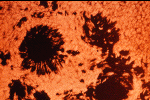Flares
Because sunlight is so bright, astronomers can filter it down to a narrow band of color emitted by some specific atom ("spectral line"), and still have enough brightness left to observe the Sun in detail. Pictures taken of the Sun in such filtered light show much more detail than pictures taken in plain sunlight, and contain additional information: for instance, the magnetic nature of sunspots was found by observing them in spectral lines sensitive to magnetic fields.
Certain spectral lines (e.g. the red line of hydrogen) are particularly useful, because they come from high levels in the Sun's atmosphere. When the Sun is observed in the light of such lines, a sudden brightening is now and then seen near sunspots, at times expanding tens of thousands of kilometers in a matter of minutes. Such abrupt events were named solar flares, and what made them especially interesting was that occasionally, after a prominent flare, a magnetic storm would erupt on Earth. It suggested that the flare released some disturbance which traveled through space and took a day or two to reach Earth. Considering the vastness of interplanetary space, a great amount of energy had to be released in a very short time to produce this effect.
A century later we know a great deal more about flares, but have yet to trace the process of their energy release. It is generally held that the energy is drawn from the magnetic field, not just because of the close association between flares and sunspots, but also because theoretically only magnetic fields are capable of releasing energy so quickly. Unfortunately, it apparently happens at the higher levels of the Sun's atmosphere, and no good way exists of observing the magnetic field there. Starting in 1942, bursts of ions with energy comparable to that of cosmic rays were observed from some flares, and after x-ray telescopes were placed in orbit (x-rays are stopped by the atmosphere) also bursts of x-rays, sometimes rising within a second or two.
Coronal Mass Ejections
Sometimes energetic particles and magnetic storms are observed at Earth without any exceptional flare activity preceding them, but they may be associated with a different solar phenomenon, observed in 1973 by telescopes aboard the US space station Skylab. These are "Coronal Mass Ejections" (CMEs), huge bubble-shaped disturbances rising above active sunspot regions, expanding as they rise.
By that time spacecraft had already found the cause of flare-associated magnetic storms at Earth. It was the arrival of interplanetary shock fronts, marking the front edge of expanding plasma clouds which, it was then believed, arose in flares. Once CMEs were discovered, it seemed obvious that here were probably similar clouds, at the start of their journey outwards from the Sun.
Some CMEs come with flares, some don't, and many scientists nowadays feel that CMEs are more frequently associated than flares with the rapid release of magnetic energy on the Sun. The real mystery, of course, is the release process itself.
CMEs heading straight for the Earth are not easy to observe, because they are seen against the background of the bright Sun. Nevertheless, instruments aboard the solar observatory SOHO , launched in 1996, towards the Lagrangian point L1, are able to do so, and have been used since early 1997 in space weather prediction. Some time after the year 2000 NASA hopes to launch a "solar stereo" mission, with a spacecraft in the Earth's orbit but 60 or 90 degrees away from the Earth's position: such a spacecraft would be placed to observe CMEs heading from Earth from their side.
Further Explorations
Click here for a detailed exposition on the Sun, by Bill Arnett.
http://umbra.nascom.nasa.gov/images/ is a useful compilation of solar information, including the most recent images of the Sun from various observatories. The images are taken through filters which isolate narrow ranges of color ("spectral lines") emitted by selected substances, and show great detail about active solar regions.
Tutorial on Sunspots and their Cycle
For serious amateurs: Introduction to Solar Observing (chapt. 1: The Sun) by John Chapman-Smith, a site of the Society for Popular Astronomy (SPA). This is followed by chapters on telescopes, making a solar observations, Stonyhurst disks, filters etc.
"A Guide to the Sun" by Kenneth J.H. Philips, Cambridge Univ. Press 1992 (Paperback 1995). An excellent non-mathematical exposition of solar physics, covering all subjects discussed here and much more.
"Sun Observer's Guide" by Pam Spence,159 pp., Firefly Books, 2004. A concise and readable overview.
Questions from Users:
*** 